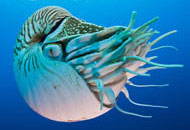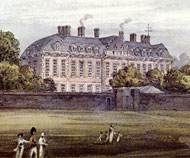Hans Sloane’s nautilus shell
Sir Hans Sloane is perhaps the most important collector ever. His huge collection forms the core of both the British Museum and the Natural History Museum. This shell of the nautilus Nautilus pompilius is one of the most beautiful specimens. It was carved by Dutch artist Johannes Belkien in the late 1600s.
Improving perfection
Sloane was captivated by beautiful objects. He must have particularly prized this nautilus shell as its coil follows the golden ratio used by Leonardo da Vinci to create proportions pleasing to the human eye.
Sloane may have believed the carving by Belkien improved on its natural perfection. It is the only Belkien carving bearing his full signature.

Pearly nautilus, Nautilus pompilius, swimming in waters off Australia. © Reinhard Dirscherl, Visuals Unlimited / Science Photo Library
Living fossil
Nautiluses have changed so little in the past 350 million years that they are known as living fossils.
They were once some of the largest sea predators, but now need protection from humans. Their beauty drives the capture of 1000s each year. Hopefully export bans will encourage humans to treasure these animals more when they are alive than dead.
Cabinets of curiosity
Born in 1660, Sloane became a naturalist, a doctor to the rich and famous, and a prolific collector.
At a time when Europeans were making voyages of discovery around the world, collecting curious specimens and artefacts from far-flung places became a popular and prestigious hobby. Sloane used his wealth to build an unrivalled collection.

Montague House in Bloomsbury, London, was the first home of the British Museum, which was founded using Sloane's collection after he died. The natural history objects later formed the core of the Natural History Museum.
Birth of a museum
Sloane spent over £100,000 (many millions today) accumulating more than 400,000 objects, from plants and animals to antiquities and books.
He wanted to share them with the general public as well as academics. So he requested that they be sold to the nation on his death for £20,000. The funds to buy them were raised through a national lottery and they formed the founding collection of the British Museum.
In 1881, the natural history collections, including this carved nautilus shell, were re-housed in the Waterhouse building at South Kensington, which became part of the Natural History Museum.
Sloane’s wishes have been fulfilled many times over. His collections have been studied and added to by the greatest scientific minds and are enjoyed by millions of visitors each year.
Further information
- Visit Sloane's nautilus shell in our new Treasures Cadogan Gallery.
- Watch a video about Sloane's voyage to Jamaica, and how he brought hot chocolate to England.
- Discover the first collectors, voyages and people instrumental to the formation of the Natural History Museum.
Vote for your favourite treasure
Is this your favourite Museum treasure? Let us know by voting in our poll.